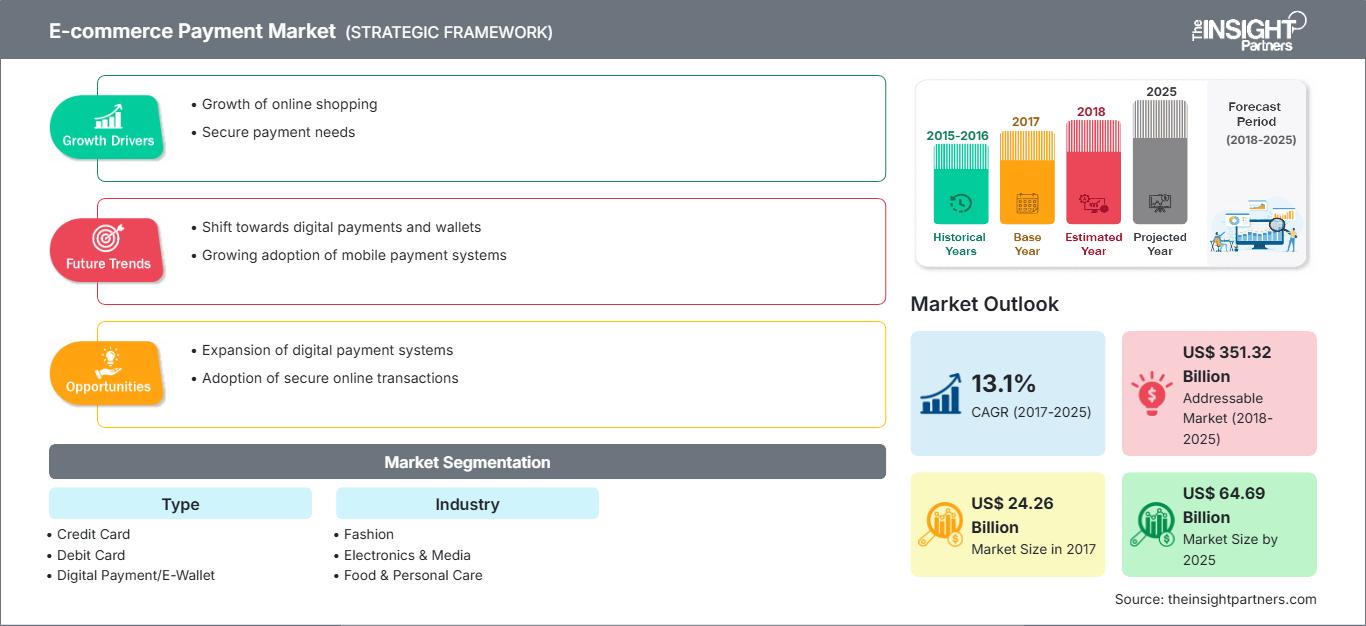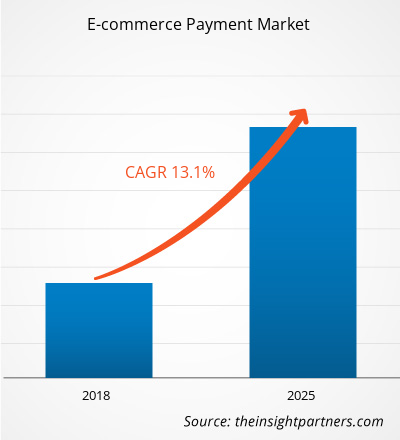Se espera que el mercado global de pagos de comercio electrónico crezca de US$ 24,26 mil millones en 2017 a US$ 64,69 mil millones en 2025 a una CAGR del 13,1% entre 2018 y 2025.
El mercado de pagos de comercio electrónico está experimentando un crecimiento a nivel mundial, con una creciente preferencia por los pagos en línea gracias a la disponibilidad de diversos métodos de pago. Además, la creciente adopción de teléfonos inteligentes y la disponibilidad de internet también impulsan el crecimiento del mercado de pagos de comercio electrónico. Además, debido al creciente número de usuarios bancarios y a la digitalización, se prevé un auge del mercado de pagos de comercio electrónico durante el período de pronóstico. El informe se centra en una segmentación exhaustiva del mercado de pagos de comercio electrónico según tipo, sector vertical y geografía.
Perspectivas del mercado
APAC es reconocida como la región líder durante todo el período de pronóstico
La región Asia Pacífico comprende varios países en desarrollo, como Corea del Sur, India, Indonesia y Malasia, entre otros. Estos países están experimentando un alto crecimiento demográfico, lo que se traduce en un crecimiento del mercado de pagos electrónicos. La industria del comercio electrónico en la región está en pleno auge gracias a la creciente penetración de internet y la alta adopción de teléfonos inteligentes y tabletas. Asimismo, los gobiernos de las economías emergentes están tomando iniciativas para mejorar la bancarización de la población, proporcionando así una mejor plataforma para la industria de pagos en línea. Recientemente, se ha observado un cambio: los consumidores de APAC prefieren pagar en línea mediante métodos de pago alternativos, como monederos electrónicos, transferencias bancarias y tarjetas de crédito y débito. Se espera que el creciente uso de estos métodos de pago contribuya significativamente al crecimiento de las pasarelas de pago en la industria del comercio electrónico durante el período de pronóstico. Se prevé que estos factores impulsen aún más la demanda del mercado de pagos electrónicos en la región APAC.
Obtendrá personalización en cualquier informe, sin cargo, incluidas partes de este informe o análisis a nivel de país, paquete de datos de Excel, así como también grandes ofertas y descuentos para empresas emergentes y universidades.
Mercado de pagos de comercio electrónico: Perspectivas estratégicas

-
Obtenga las principales tendencias clave del mercado de este informe.Esta muestra GRATUITA incluirá análisis de datos, desde tendencias del mercado hasta estimaciones y pronósticos.
El modelo de negocio en el comercio minorista sigue sin explotarse en la región de Medio Oriente, lo que ofrece un enorme potencial para los actores de la industria.
Los pagos digitales en Oriente Medio se encuentran en un punto de inflexión, ya que las regulaciones, la cultura y la tecnología experimentan cambios de paradigma, lo que abre la puerta a empresas innovadoras para revolucionar los ecosistemas de pago más antiguos. Más del 80 % de los pagos minoristas en tiendas físicas y el 65 % de los pagos de comercio electrónico aún se realizan en efectivo, y la adopción de teléfonos inteligentes supera el 100 % en varios países. La penetración de la telefonía móvil en la región MEA está al borde de una nueva era, impulsada por la evolución del comportamiento del consumidor, la rápida industrialización, las ambiciones gubernamentales y la cambiante situación económica. Se han identificado oportunidades en el crecimiento del acceso a datos y los ingresos, que son cada vez más sustanciales y experimentan un fuerte crecimiento; así como en los servicios de pago digital. Esto se ve confirmado por el hecho de que la penetración de teléfonos inteligentes en la región supera el 65 %. Además, más de dos tercios de la población utiliza internet, con una penetración en los Emiratos Árabes Unidos y Catar que supera el 90 %. La región cuenta con una población considerable de personas adineradas con afición por los bienes de lujo.
La iniciativa de mercado se consideró la estrategia más adoptada en el mercado global de pagos de comercio electrónico. A continuación, se enumeran algunas de las estrategias recientes de algunos actores del mercado de pagos de comercio electrónico:
2018: PayPal anunció la ampliación de su acuerdo de colaboración con eBay. Gracias a este acuerdo, eBay continúa promocionando y aceptando PayPal Credit a través de su plataforma de mercado.
2018: Alipay anunció su lanzamiento en 20 países europeos a finales de este año. La compañía firmó contratos con más de 40 empresas de monederos digitales y 100 bancos en toda Europa.
2018: Visa, Inc. anunció la ampliación de su colaboración con PayPal a Canadá para acelerar la implementación de pagos móviles y digitales fiables, seguros y adecuados para comerciantes y consumidores.
Perspectivas regionales del mercado de pagos de comercio electrónico
Los analistas de The Insight Partners han explicado detalladamente las tendencias regionales y los factores que influyen en el mercado de pagos de comercio electrónico durante el período de pronóstico. Esta sección también analiza los segmentos y la geografía del mercado de pagos de comercio electrónico en América del Norte, Europa, Asia Pacífico, Oriente Medio y África, y América del Sur y Central.
Alcance del informe sobre el mercado de pagos de comercio electrónico
| Atributo del informe | Detalles |
|---|---|
| Tamaño del mercado en 2017 | US$ 24.26 mil millones |
| Tamaño del mercado en 2025 | US$ 64.69 mil millones |
| CAGR global (2017-2025) | 13,1% |
| Datos históricos | 2015-2016 |
| Período de pronóstico | 2018-2025 |
| Segmentos cubiertos |
Por tipo
|
| Regiones y países cubiertos |
América del norte
|
| Líderes del mercado y perfiles de empresas clave |
|
Densidad de actores del mercado de pagos de comercio electrónico: comprensión de su impacto en la dinámica empresarial
El mercado de pagos en el comercio electrónico está creciendo rápidamente, impulsado por la creciente demanda del usuario final debido a factores como la evolución de las preferencias de los consumidores, los avances tecnológicos y un mayor conocimiento de los beneficios del producto. A medida que aumenta la demanda, las empresas amplían su oferta, innovan para satisfacer las necesidades de los consumidores y aprovechan las tendencias emergentes, lo que impulsa aún más el crecimiento del mercado.

- Obtenga una descripción general de los principales actores clave del mercado de pagos de comercio electrónico
Segmentación del mercado global de pagos de comercio electrónico
Por tipo
- Tarjeta de crédito
- Tarjeta de débito
- Pago digital/monedero electrónico
- Banca por Internet
- Tarjetas de regalo
- Otros
Por industria
- Moda
- Electrónica y medios
- Alimentos y cuidado personal
- Muebles y Electrodomésticos
- Industria de servicios
- Otros
Por geografía
-
América del norte
- A NOSOTROS
- Canadá
- México
-
Europa
- Francia
- Alemania
- Italia
- España
- Reino Unido
- Resto de Europa
-
Asia Pacífico (APAC)
- Australia
- Porcelana
- India
- Japón
- Resto de APAC
-
Oriente Medio y África (MEA)
- Arabia Saudita
- Emiratos Árabes Unidos
- Sudáfrica
- Resto de MEA
-
América del Sur (SAM)
- Brasil
- Resto de SAM
Perfiles de empresas
- PayPal Holdings, Inc.
- Pagos de Amazon, Inc.
- CCBill, LLC
- WePay Inc.
- Alipay
- Visa, Inc.
- MasterCard Incorporated
- Stripe Inc.
- Compañía American Express
- UnionPay International Co., Ltd.
- Análisis histórico (2 años), año base, pronóstico (7 años) con CAGR
- Análisis PEST y FODA
- Tamaño del mercado, valor/volumen: global, regional y nacional
- Industria y panorama competitivo
- Conjunto de datos de Excel
Informes recientes
Testimonios
Razón para comprar
- Toma de decisiones informada
- Comprensión de la dinámica del mercado
- Análisis competitivo
- Información sobre clientes
- Pronósticos del mercado
- Mitigación de riesgos
- Planificación estratégica
- Justificación de la inversión
- Identificación de mercados emergentes
- Mejora de las estrategias de marketing
- Impulso de la eficiencia operativa
- Alineación con las tendencias regulatorias






















 Obtenga una muestra gratuita para - Mercado de pagos de comercio electrónico
Obtenga una muestra gratuita para - Mercado de pagos de comercio electrónico